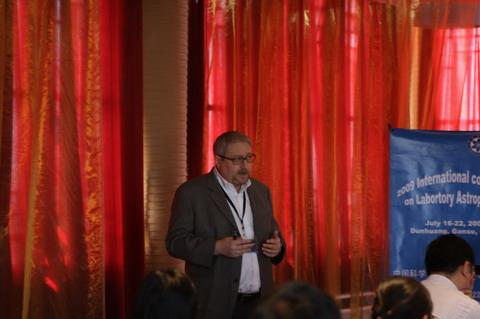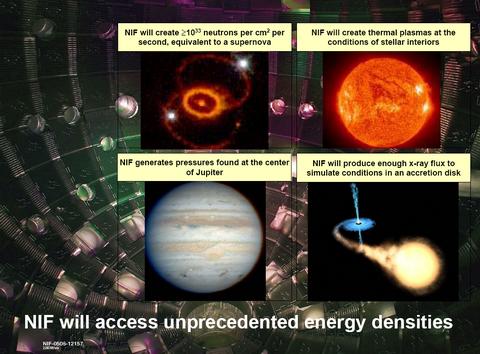研究動向調査報告書:Report after attending the LCLA 2009 conference
大阪大学レーザーエネルギー学研究センター
Hongbo Cai
出張期間:平成20年 7月16日〜7月22日
出張先: Dunhuang, Gansu province, China
In order to seize the development in the field of laboratory astrophysics and high energy particle beam acceleration, I attended 2009 International Conference on Laboratory Astrophysics (LCLA 2009, July 16-22nd), which was hold in Silk Road Dunhuang Hotal, Dunhuang, Gansu province, China. The co-chairs of this conference are Prof. G. Zhao (CAS, China) and Prof. H. Takabe (ILE, Osaka Univ.). The conference covers many topics including: compressible hydrodynamic mixing, strong shock phenomena, radiation flow, radiative shocks and jets, complex opacities, equations of state, superstrong magnetic fields, and relativistic plasmas et al.
At the conference, I also gave an oral presentation about the effects of the pre-pulse on the generation of the high energy particles: Effects of preformed plasma on the generation of high energy electrons in interaction of ultra-intense picoseconds laser pulse with high-Z solid targets are described. The pre-plasma is strongly dependent on the pre-pulse and the amplified spontaneous emission (ASE) pedestal. Experiments [1] showed that the opaque pre-plasma can be extended up to ~100 microns under the irradiance of an ASE at intensity. In the present manuscript, the initial density profiles are determined by the contrast ratio via the radiation hydrodynamic simulation [2]. The coupling of the laser energy to the plasma, the energy spectrum and flux of the accelerated electrons observed at the rear side of the cone target, and the deformation of the pre-plasma with the interaction of the picoseconds main pulse are studied via the particle-in-cell simulation code. Different initial density profiles depending on the results of the hydrodynamic simulations are discussed. The acceleration mechanisms of the high energy electrons in different initial cases are analyzed in detail. After several picoseconds, the number of high energy electrons (0.5MeV < E < 2MeV) in a short scale length ramp case can be several times larger than that of a long scale length case. In order to generate the high energy electrons [0.510^8).The generation of such very-high-energy electrons is pivotal in a number of important novel applications, such as Fast Ignitor (FI) scheme, nuclear physics and laboratory-astrophysics.
At the conference, a lot of scientists gave impressive presentations. W. Goldstein (LLNL, USA) presented “Prospects for Laboratory Astrophysics at the National Ignition Facility”. He Introduced the NIF, the world’s largest and most powerful laser system. NIF will produce 1.8MJ, 500TW of ultraviolet light. Besides the goal of achieving the ignition, it also capable of driving targets to conditions equivalent to those found in stellar interiors, at the cores of giant planets, and in photoionized nebulae.
H. Takabe (ILE, Osaka Univ.) reviewed the recent activities of laboratory astrophysics and future direction of this discipline. He also introduced the observation of x-ray observed from companion star of Cyg X-3, and experimental study of x-ray from imploded CH core plasma, which is related to the generation of high energy electrons. M. Murakami (ILE, Osaka Univ.) showed a practical tool to study super-high pressure phenomena?impact ignition. In his presentation, a super-high velocity, 1000km/s, has been experimentally demonstrated. By controlling the Br-dope, the particle acceleration performance can be optimized. The extremely high pressure of 1Tbar has been achieved, which is useful for studying various astrophysical phenomena. Y. T. Li (CAS, Beijing) showed the recent studies of laboratory astrophysics at the institute of Physics. Experiments of photoionized plasmas and shock wave generation have been preformed with the Shengguang II laser facility.
Y. Kuramitsu (ILE, Osaka Univ.) studied the wave field acceleration process. When the laser intensity is relativistic and the spatial scale of laser is larger than electron inertial scale, the electrons are nonthermally accelerated by incoherent wakefields. The distribution functions are universally represented by power-law spectra with an index of ~2 independent of the laser intensity and plasma density. In the incoherent wakefield the maximum energy can be much larger than one in the coherent field due to the momentum space diffusion or the energy diffusion of electrons.
N. Kawai (Tokyo institute of technology) introduced the Gamma-Ray bursts. He told us most of people believed that GRBs come from neutron stars, but sometimes it is not true. C. Gregory (LULI, France) showed the recent activity in the field of laboratory astrophysics at the LULI laboratory. The jet experiments have produced jets from a variety of targets, and plasmas that are in a regime that may be scalable. Also, the particle acceleration processes are affected by different targets. Other researchers from USA, Japan, and China also gave some interesting talks, but due to the limitation of the pages, I cannot report all of them.
References
[1] S. D. Baton, M. Koenig, J. Fuchs et al., Phys. Plasmas 15, 042706 (2008).
[2] A. Sunahara et al., submitted to IFSA 2009.

Fig. 1. W. Goldstein is giving his presentation.

Fig. 2. Applications of NIF, from Goldstein’s presentation at the conference.
|






